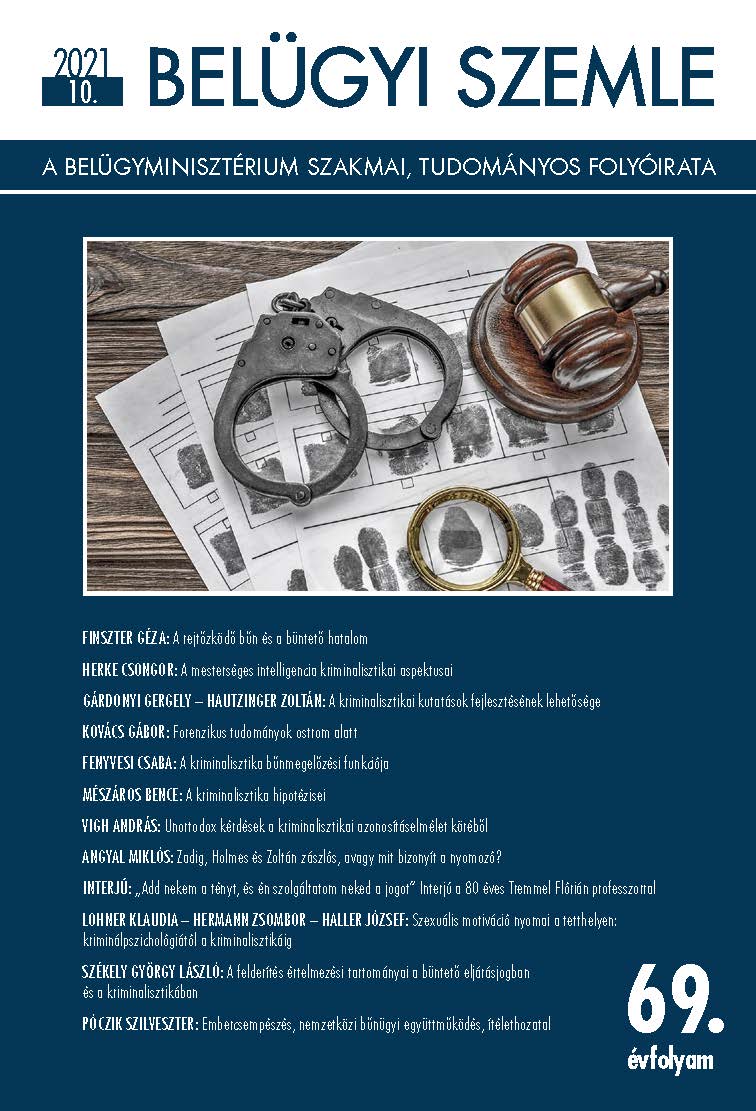Keywords
face recognition
Bayes-analysis
crime prevention
electronic data
Bayes-analysis
crime prevention
electronic data
How to Cite
Crime Prevention Function of Criminalistics. (2021). Academic Journal of Internal Affairs, 69(10), 1759-1769. https://doi.org/10.38146/BSZ.2021.10.5
Abstract
Criminalistics is, in essence, mainly a practical and – to a sm aller extent – theoretical science of criminal investigation, in other words, it is a branch of criminal sciences that explores, creates, systemizes and applies – within normative legal frames - means and methods for the detection (prevention) and proof of crime. This study analysis the crime prevention function and fields of criminalistics and shows up present and future potential criminalistic preventive possibilities, methods.
Downloads
Download data is not yet available.
Similar Articles
- Gabriella Németh, Translation and certification of documents in due process, with particular reference to questioned and electronic documents , Academic Journal of Internal Affairs: Vol. 71 No. 12 (2023)
- Laura Schmidt, Criminology MA , Academic Journal of Internal Affairs: Vol. 69 No. 6 (2021)
- Imre Elek, László Hanka, Fragmented footprints as evidence , Academic Journal of Internal Affairs: Vol. 62 No. 3 (2014)
- István Jenő Molnár, The role of traffic management in crime prevention , Academic Journal of Internal Affairs: Vol. 67 No. 9 (2019)
- Nikolett Ujfalussy , The big law enforcement information exchange challenge , Academic Journal of Internal Affairs: Vol. 72 No. 9 (2024)
- Judit Nagy, Károly Orsós, Communication and prevention , Academic Journal of Internal Affairs: Vol. 65 No. 3 (2017)
- Csaba Orbán, Public security: A secondary effect for criminal investigation , Academic Journal of Internal Affairs: Vol. 65 No. 5 (2017)
- Violetta Rottler, The authorisation procedure of private security operations in the United Kingdom and the operating structure of private security management in Hungary , Academic Journal of Internal Affairs: Vol. 69 No. 3 (2021)
- Valér Dános, Together for the Security , Academic Journal of Internal Affairs: Vol. 69 No. 8 (2021)
- Andrea Tünde Barabás, Criminolgoy, crime prevention and the police , Academic Journal of Internal Affairs: Vol. 63 No. 12 (2015)
You may also start an advanced similarity search for this article.
Most read articles by the same author(s)
- Csaba Fenyvesi, The second version of the criminalist pyramid-model , Academic Journal of Internal Affairs: Vol. 62 No. 9 (2014)
- Csaba Fenyvesi, Justizmord and investigative errors , Academic Journal of Internal Affairs: Vol. 62 No. 3 (2014)
- Csaba Fenyvesi, Jack the Ripper and modern forensic methods , Academic Journal of Internal Affairs: Vol. 65 No. 7-8 (2017)
- Csaba Fenyvesi, Presentation for recognition and faith , Academic Journal of Internal Affairs: Vol. 66 No. 4 (2018)
- Csaba Fenyvesi, József Orbán, Electronic data as a cornerstone of the 7-5-1 forensic pyramid model , Academic Journal of Internal Affairs: Vol. 67 No. 2 (2019)
- Csaba Fenyvesi, Every police organization is only as good as its data , Academic Journal of Internal Affairs: Vol. 70 No. 11 (2022)
- Csaba Fenyvesi, Global trends in forensic science in the 21st century , Academic Journal of Internal Affairs: Vol. 61 No. 10 (2013)
- Csaba Fenyvesi, Concepts and academic approaches in criminal investigation in continental and common law , Academic Journal of Internal Affairs: Vol. 63 No. 2 (2015)
- Csaba Fenyvesi, The role of line-up and digital data in a specific indidency case , Academic Journal of Internal Affairs: Vol. 64 No. 9 (2016)
- Csaba Fenyvesi, Ferenc Kodba, Criminalistic Turns of the Murder Case in Pécs on Palahegyi Street in 1974 , Academic Journal of Internal Affairs: Vol. 68 No. 4 (2020)

